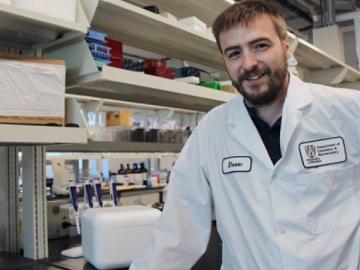
Filter News
Area of Research
- (-) Computational Engineering (3)
- (-) Fusion and Fission (14)
- (-) National Security (35)
- (-) Neutron Science (132)
- Advanced Manufacturing (24)
- Biological Systems (2)
- Biology and Environment (89)
- Building Technologies (3)
- Computational Biology (2)
- Computer Science (17)
- Electricity and Smart Grid (1)
- Energy Science (181)
- Energy Sciences (1)
- Functional Materials for Energy (1)
- Fusion Energy (4)
- Isotope Development and Production (1)
- Isotopes (8)
- Materials (148)
- Materials Characterization (1)
- Materials for Computing (22)
- Materials Under Extremes (1)
- Mathematics (1)
- Nuclear Science and Technology (15)
- Quantum information Science (8)
- Sensors and Controls (1)
- Supercomputing (131)
- Transportation Systems (1)
News Topics
- (-) 3-D Printing/Advanced Manufacturing (11)
- (-) Artificial Intelligence (20)
- (-) Bioenergy (11)
- (-) Biomedical (18)
- (-) Composites (2)
- (-) Computer Science (35)
- (-) Materials Science (25)
- (-) Microscopy (4)
- (-) Neutron Science (120)
- (-) Security (13)
- Advanced Reactors (8)
- Big Data (9)
- Biology (11)
- Biotechnology (2)
- Buildings (2)
- Chemical Sciences (9)
- Clean Water (3)
- Coronavirus (12)
- Critical Materials (1)
- Cybersecurity (19)
- Education (1)
- Energy Storage (12)
- Environment (16)
- Exascale Computing (2)
- Fossil Energy (2)
- Frontier (3)
- Fusion (23)
- Grid (8)
- High-Performance Computing (9)
- Hydropower (1)
- Isotopes (1)
- ITER (6)
- Machine Learning (16)
- Materials (16)
- Mathematics (2)
- Nanotechnology (12)
- National Security (35)
- Nuclear Energy (33)
- Partnerships (8)
- Physics (11)
- Polymers (1)
- Quantum Computing (1)
- Quantum Science (8)
- Simulation (4)
- Space Exploration (3)
- Summit (8)
- Transportation (9)
Media Contacts

Does vaping and smoking e-cigarettes put you at higher risk of COVID-19 complications? UWindsor’s Drew Marquardt is trying to answer that question with research into how the toxicants in the oils of vapes and e-cigarettes affect lung function.

Research by an international team led by Duke University and the Department of Energy’s Oak Ridge National Laboratory scientists could speed the way to safer rechargeable batteries for consumer electronics such as laptops and cellphones.

In the race to identify solutions to the COVID-19 pandemic, researchers at the Department of Energy’s Oak Ridge National Laboratory are joining the fight by applying expertise in computational science, advanced manufacturing, data science and neutron science.

Oak Ridge National Laboratory researchers working on neutron imaging capabilities for nuclear materials have developed a process for seeing the inside of uranium particles – without cutting them open.

A versatile class of flexible, protein-like polymers could significantly advance future drug delivery methods. But first, scientists have to develop a reliable process for tailoring these polymers into shapes that can effectively transport medicines throughout the human body.

Biological membranes, such as the “walls” of most types of living cells, primarily consist of a double layer of lipids, or “lipid bilayer,” that forms the structure, and a variety of embedded and attached proteins with highly specialized functions, including proteins that rapidly and selectively transport ions and molecules in and out of the cell.

A novel approach developed by scientists at ORNL can scan massive datasets of large-scale satellite images to more accurately map infrastructure – such as buildings and roads – in hours versus days.

An international team of researchers has discovered the hydrogen atoms in a metal hydride material are much more tightly spaced than had been predicted for decades — a feature that could possibly facilitate superconductivity at or near room temperature and pressure.

A typhoon strikes an island in the Pacific Ocean, downing power lines and cell towers. An earthquake hits a remote mountainous region, destroying structures and leaving no communication infrastructure behind.



